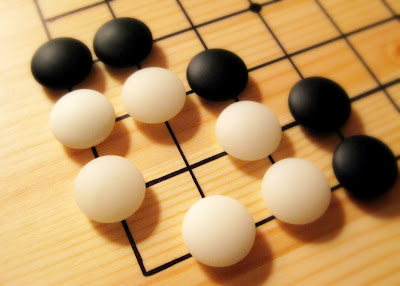
Alex recently emailed me inquiring as to how I steep my teas.
As far as my parameters for testing out a new pu-erh, this is my process:
Water: I use spring water. Not always particular on brand, so long as it's spring and not just 'purified drinking water.' The mineral content seems to enhance the taste of every tea I drink that way.
Temperature: Right now, I have a Sunbeam Hot Shot that I use for heating my water. It wasn't until recently that I discovered that although it heats the water quickly, the water comes nowhere near boiling, which is ideal for many pu-erh teas. I had been using a thermometer and ramping on the button until the water hits 200F. At that point, it will coast up a few more degrees and come close to the boiling pot without ever actually bubbling. I can't do this anymore though because it's killing my Hot Shot. I've looked at the UtiliTEA on Adagio's website. $50 well spent, in my humble opinion.
Teaware: I always test out new pu-erh in my koi gaiwan. I like to taste the leaf without the aid of a weathered pot. By doing this, the brew hides nothing.
Leaf Quantity: I usually fill the gaiwan to about 1/3 full. The leaf will expand and fill out a lot more of the gaiwan, and this has, in my own experience, given me great results in terms of flavour. Further, doing this, I rarely have to remove leaf because I've added too much. It still happens, but it's much more rare these days, which is a far cry from the surplus of leaf I used to waste and have to feed to my garbage disposal. I'm sure those blades have a healthy coating of tea-oil on them by now! ^__^
Rinse: This one varies a bit depending on whether or not it's shu or sheng and how tight the compression is. Sheng is always one rinse at 15 seconds. Shu is also at 15 seconds, but I just rinse it twice. If it's really loose, I'll cut the rinse time in half.
Steeping times: This one is something I think everyone needs to experiment with as a personal discovery, as we all have varying palates. At present, I think my steeping times have already changed three or four times, but after the rinse, this is how i do mine:
15s, 12s, 25s, 35s, 50s, 1:15, 1:25, 1:35, 1:45, 2:00, 2:15, 2:30, 3:00, 3:30, 4:00, 5:00
I don't normally go past 15 or 16 steepings unless it's something with longevity, like the LCT. At that point, if it's still hitting, it's no longer a matter of science but a sort of 'conversation' with the tea as Teddy put it. By that point, I try to feel out what the leaf is trying to say and brew longer or shorter times depending on that.
 You've likely seen it a hundred times in movies; a NAVY ship is headed out to sea and someone smashes a bottle against the hull for good luck. Well, I can only hope the woes of working Black Friday in the world of retail are the same. This morning, while packing it up to go to work, my Kyusu cracked. I watched in slow motion as the lid came crashing down onto the rim of the pot. Initially, my hand picked up the shattered piece and put it back where it went hoping it would somehow fuse itself back to the rest of the pot. In my head, a small choir would show up in my living room to sing Hallelujah, and I'd go to work like intended.
You've likely seen it a hundred times in movies; a NAVY ship is headed out to sea and someone smashes a bottle against the hull for good luck. Well, I can only hope the woes of working Black Friday in the world of retail are the same. This morning, while packing it up to go to work, my Kyusu cracked. I watched in slow motion as the lid came crashing down onto the rim of the pot. Initially, my hand picked up the shattered piece and put it back where it went hoping it would somehow fuse itself back to the rest of the pot. In my head, a small choir would show up in my living room to sing Hallelujah, and I'd go to work like intended.







